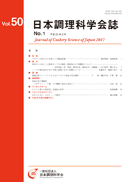All issues

Predecessor
Volume 50, Issue 5
Displaying 1-8 of 8 articles from this issue
- |<
- <
- 1
- >
- >|
Review
-
Mari Maeda-Yamamoto2017Volume 50Issue 5 Pages 167-173
Published: 2017
Released on J-STAGE: October 20, 2017
JOURNAL FREE ACCESSDownload PDF (1955K)
Original paper
-
Takako Koriyama, Kumiko Iijima, Fumiko Konishi, Yoko Sato, Midori Kasa ...2017Volume 50Issue 5 Pages 174-181
Published: 2017
Released on J-STAGE: October 20, 2017
JOURNAL FREE ACCESSMucuna beans, a high-yielding legume variety, contain L-3, 4-dihydroxyphenylalanine (L-DOPA), at a high concentration of 3-9% in dried seed meal. L-DOPA is a potentially toxic compound, needs to be removed from the beans prior to consumption of Mucuna beans as food. We investigated the preparation conditions and the fermentation process of miso for reducing L-DOPA concentrations in Mucuna beans to a safe level. Four types of miso prepared from Mucuna beans and soybeans at different conditions were considered: salty, with rice koji; medium-salty, with rice koji; sweet, with rice koji; and medium-salty, with barley koji. All Mucuna bean miso types were produced through a fermentation process similar to that for soybean miso, according to pH, acidity I and II, protein solubility, and colorimetric values. The amount of L-DOPA in Mucuna bean miso remained at 0.14-0.26 g/100 g in wet weight of miso at the beginning of the fermentation, and decreased to 0.01-0.15 g after one month; L-DOPA could not be detected at the end of the fermentation. The medium-salty-type Mucuna bean miso using rice koji had the highest sensory evaluation, antioxidant activities by DPPH and ORAC methods showed approximately 1.7-fold and 4.5-fold higher than those of soybean miso, respectively. These results suggest that Mucuna bean miso has functional antioxidant activity and is safe for consumption.View full abstractDownload PDF (1189K)
Note
-
Hideki Horie, Kaori Ema, Osamu Sumikawa2017Volume 50Issue 5 Pages 182-188
Published: 2017
Released on J-STAGE: October 20, 2017
JOURNAL FREE ACCESSMatcha is a type of powdered tea; it was previously regarded as a precious beverage and is served at tea ceremonies in Japan. Today, powdered teas labeled “matcha” are used in the food industry as well as in cooking; both are referred to as industrial-grade matcha in this report. Moreover, powdered green teas that are not labeled as “matcha” are also sold in the market. However, there is little information on the quality of these powdered teas. Therefore, in this study, we compared the chemical components of “matcha” and powdered green tea. Ten grades of Tencha (milled Tencha is matcha) were collected and their chemical components were analyzed. Based on the results, the contents of theanine and chlorophyll a (Chl-a) and the ratio of epigallocatechin gallate/epigallocatechin (EGCG/EGC) were compared among the powdered teas sold on the market. Tea ceremony-grade matcha was found to contain >1.8 g/100 g DW of theanine and exhibited an EGCG/EGC ratio >3.2 (weight-based). Most industrial-grade matcha and powdered green tea samples exhibited lower values; however, it was difficult to distinguish industrial-grade matcha from powdered green tea by using only these parameters. The Chl-a content of matcha for tea ceremonies was more than 250 mg/100 g DW. Powdered green tea samples, except for Gyokuro powders, exhibited low Chl-a contents relative to both ceremonial and industrial grade matcha samples.View full abstractDownload PDF (776K)
Technical report
-
Noriko Tanaka, Makiko Katayose, Kaoru Sakamoto, Hironori Masui, Tomoko ...2017Volume 50Issue 5 Pages 189-197
Published: 2017
Released on J-STAGE: October 20, 2017
JOURNAL FREE ACCESSExtracted data from three generations of students, parents, and grandparents in Hyogo Prefecture concerning 17 Japanese annual events (e.g., New Year's Eve, the New Year, seasonal events or festivals, and Buddhist events), were analyzed for intergenerational transmission. The results obtained were as follows: Shogatsu (New Year's celebration), Omisoka (New Year's Eve), Christmas, and Setsubun (seasonal events), all of which include traditional meals and dishes (e.g., Zoni, soba, cake, Makizushi), were recognized and experienced by almost everyone, including people from all generations. The annual events, which were well recognized but infrequently experienced, were Otsukimi, Jinjitsu, Tango, Shunbun (Spring Equinox), Touji, and Shuubun (Autumnal Equinox). Among them, Shunbun and Shuubun, in particular, were not passed down through the generations as family traditions. The autumn festival and spring festival were already less recognized and less experienced, and so these celebrations will probably fade away with time. Among 17 events, Chouyou was the least experienced event, with only a few percent of the students having attended. In other words, this event has almost become irrelevant to contemporary Japan.View full abstractDownload PDF (988K)
Course text
-
Koji Sakamoto2017Volume 50Issue 5 Pages 198-203
Published: 2017
Released on J-STAGE: October 20, 2017
JOURNAL FREE ACCESSDownload PDF (1330K)
Educational materials research
-
Tomoko Watanabe2017Volume 50Issue 5 Pages 204-207
Published: 2017
Released on J-STAGE: October 20, 2017
JOURNAL FREE ACCESSDownload PDF (956K)
Cooking room
-
Emiko Sato2017Volume 50Issue 5 Pages 208-212
Published: 2017
Released on J-STAGE: October 20, 2017
JOURNAL FREE ACCESSDownload PDF (1370K)
Topics & opinion
-
Wataru Kobayashi2017Volume 50Issue 5 Pages 213-215
Published: 2017
Released on J-STAGE: October 20, 2017
JOURNAL FREE ACCESSDownload PDF (817K)
- |<
- <
- 1
- >
- >|